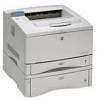HP 5100tn Printer Job Language - Technical Reference Manual - Page 198
Requesting Printer, Status, Using Status, Readback in a, Multi-User System
 |
View all HP 5100tn manuals
Add to My Manuals
Save this manual to your list of manuals |
Page 198 highlights
Requesting Printer Status When querying the printer for status, the response is not immediate. Wait a fixed amount of time for a response and then time out. If the printer is still working on a previous print job, it may take a while before a response is received. Your application should be able to discard unexpected status, such as unsolicited status, and discard unrecognizable lines. Lines within the PJL status response begin with a specific keyword, as described in the command description in Chapter 7, and end with the control codes. Future printers may support new keywords in the PJL status response. Your application should ignore those lines which it does not understand. Using Status Readback in a Multi-User System The printing system consists of all components involved in the process of turning an application document into a printed sheet of paper. Common printing system components include the host computer, applications on the host computer, the operating system used by the host computer, the cable connecting the host computer to the printer, and the printer. Other printing system components can include printer sharing boxes, network servers, spoolers running on network servers, and I/O cards installed in the printer. For printer status readback to be useful, all components must be bi-directional. Some operating system environments, like Microsoft's Windows, provide the components that interact with the printer so Windows applications generally do not need to support printer status readback. The components that may generate printer queries include the host application, the printer sharing box, the network spooler, and the I/O card installed in the printer. Printer status readback can allow many printing system components to function more effectively, not just the host application. For example, a network I/O card may inject a PJL JOB command at the beginning of each job and a PJL 10-18 Programming Tips















